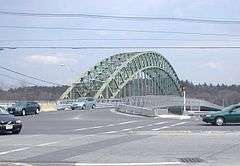Tyngsborough Bridge
| Tyngsborough Bridge | |
|---|---|
 The arch bridge in Tyngsborough, Massachusetts, with the Temporary bridge alongside it in 2006 | |
| Coordinates | 42°40′34″N 71°25′17″W / 42.67605°N 71.42133°WCoordinates: 42°40′34″N 71°25′17″W / 42.67605°N 71.42133°W |
| Crosses | Merrimack River |
| Locale | Tyngsborough, Massachusetts |
| Official name | Tyngsborough Bridge |
| Owner | Massachusetts Highway Department |
| Preceded by | Whipple Truss Bridge |
| Characteristics | |
| Design | Tied-arch bridge |
| Material | Steel |
| Total length | 656 feet (200 m) |
| Width | 41.5 feet (12.6 m) |
| Longest span | 547 feet (167 m) |
| Number of spans | 1 |
| Piers in water | 0 |
| Load limit | M 18 |
| History | |
| Designer | MassHighway in-house Design Unit |
| Constructed by | Simpson Bros. Corporation and Boston Bridge Words |
| Opened | 1930 |
| Rebuilt | 1975 |
| Statistics | |
| Daily traffic | 22,300 (2007) |
 Tyngsborough Bridge Location in Massachusetts | |
The Tyngsborough Bridge is a steel tied-arch bridge located in Tyngsborough, Massachusetts and carries Route 113 over the Merrimack River. With a span of 547 feet, it has the longest span of any steel rib through arch bridges in Massachusetts. It is also the 2nd oldest steel rib through arch bridge in the state. The bridge is center hinged and features pratt-type trussing.[1][2]
History
The Tyngsborough Bridge was constructed in 1931 to replace the wooden Whipple Truss Bridge. Starting in 1975 the bridge was rebuilt, but the cost of the construction generated controversy.[3]

In November 2005, the bridge was closed again for repairs following reports of structural deficiency. The temporary Mabey Panel Bridge was constructed alongside of the main bridge and repairs on the main bridge began in 2009. The repair operation was contracted out to S & R Corp. for $16.4 million, but eventually cost $19 million by the completion of the project. This was partially due to delays with steel girders failing stress tests which requiring re-engineering and the discovery that the original bridge had been constructed with lead paint. This required S & R Corp. to take measures to ensure that the paint chips did not fall into the river below. The repairs took three years to complete with the bridge reopening in 2012.[4][5]
References
- ↑ "Tyngsborough Bridge". mhd.state.ma.us. Massachusetts Department of Transport Highway Division. Retrieved 22 June 2015.
- ↑ "National Bridges Entry". nationalbridges.com. National Bridges. Retrieved 22 June 2015.
- ↑ "Tyngsboro Voters Face One of the Largest Ballots in Recent History Tomorrow". The Lowell Sun. May 10, 1976. p. 36. Retrieved June 22, 2015 – via Newspapers.com.

- ↑ Collins, John (July 7, 2009). "Tyngsboro Bridge is under repair". The Lowell Sun. Retrieved 26 June 2015.
- ↑ Favot, Sarah (September 11, 2012). "547 feet never meant so much". The Lowell Sun. Retrieved 26 June 2015.